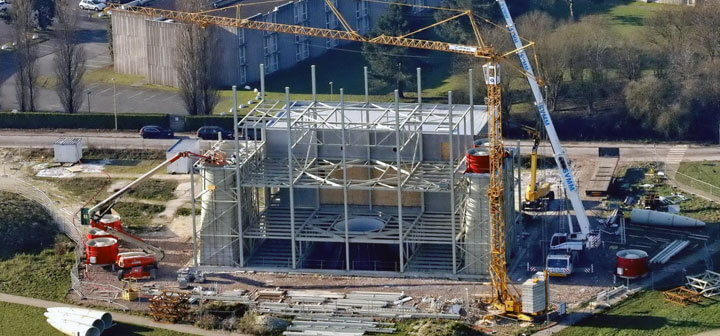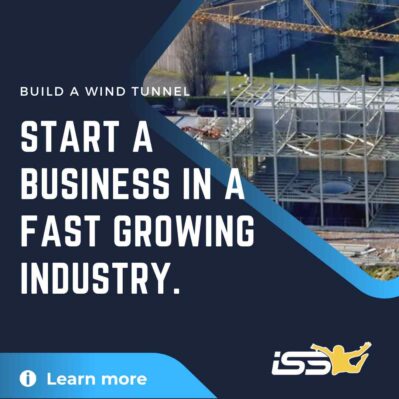Technical Information
Build an Indoor Skydiving Facility
Start a business in one of the fastest growing industries around the world.

[the_ad_placement id=”article-above-content-mobile-only”]
Indoor Skydiving Source has 12+ years of experience in the industry and has cataloged the only complete set of data for indoor skydiving facilities across all manufacturers. Continuing with our un-biased role, we present this article to anyone who is interested in building and operating an indoor skydiving facility. We also cover the smaller niche market of temporary setups for things like events or seasonal installations.
ISS has worked with manufacturers, operators and potential wind tunnel operators since 2014. The following document will help guide you through the very basics to do with building and operating a wind tunnel. If you have any questions or would like to inquire further, please browse the resources found within this website or find a full up-to-date list of manufacturers here and contact one or more of them.
Indoor Skydiving Markets & Applications
There are 3 main markets for vertical wind tunnels:
Public Facilities
By far the largest market for vertical wind tunnels is the wide range of public facilities that are open and operating all around the world. The consumer demographic of these facilities are first time participants. Local skydivers as well as the growing community of hobbyist to professional wind tunnel flyers make up a generally lesser, but often significant portion of the business. Because of the safe nature of wind tunnel flying, the limits for participants are usually very few. Almost anyone who is physically fit may fly. Ages normally range from about 4 years old on up with a roughly weight limit of roughly 260 lbs (120 kg) being the only other common restriction.
A trained staff of safety officers (instructors) helps teach, fly and keep all customers safe. Commonly wind tunnels include facilities for hosting group events like birthday parties, corporate events etc. Also common are additional facilities either onsite or nearby. Examples include other amusement activities such as a flowrider, indoor rock climbing wall, or indoor skiing. Also commonly found at a wind tunnel facilities are an attached restaurant/bar. We keep the only unbiased and up-to-date listing of every wind tunnel in the world.
Rental for Events, Shows & Temporary Installations
Indoor skydiving has appeared at many large scale events such as the NFL Draft, the closing ceremony of the Olympic Games, for filming special events and more. These installations require a certified staff, which normally is part of the rental agreement. Due to the varied nature of events, pricing is hard to estimate. For all rental inquiries, submit your information via the inquiry form at the bottom of this page.
Military Facilities & Training
Forces around the world employ wind tunnel training for their troops. Some use public facilities while others have constructed their own for private operation. You can see examples of these facilities in our private/closed section.
Personal Facilities
These are few and far between, but do exist. For an example see: SkyVenture Nad al Sheba.
Building a Wind Tunnel
Types & Sizes of Wind Tunnel
When starting an indoor skydiving business, identifying the type of wind tunnel you seek to construct is an important first step. The type and size of tunnel are very dependent on the location that you plan to build. If you are unfamiliar with the different types of vertical wind tunnels, I highly suggest you read our article on the subject. Portable & permanent installations can be any of the various tunnel types and sizes.
Portable vs Permanent
- Portable tunnels are often propeller design or open flow designs that are much noisier. This limits the amount of locations available to operate. These machines are also often smaller and consume less power, requiring smaller surrounding populations or even supporting seasonal locations. These tunnels often require favorable weather in order to operate.
- Permanent installations require major construction that often includes digging large holes in order to accommodate the return air chamber. Most modern, permanent installations are now recirculating in design with chillers as an option. As the recirculating design naturally heats up, adding chillers to a closed loop allows facilities to temperature control the air flow. Modern recirculating designs can operate in any weather condition which is essential when operating a year-round business.
Size & Speed
- Size: This aspect of the tunnel is pretty straight forward. Size of a tunnel is measured most commonly by the diameter of the flight chamber. The larger the diameter, the more people can fly at once. The most common size is a 14 ft (4.3 m) diameter which supports the needs of first time flyers, skydivers and indoor skydiving competition requirements.
- Speed: First time flyers fly in the belly-to-earth position which requires the slowest air speed of any position. This means that even the slowest wind tunnels are able to accommodate for the main indoor skydiving market. Almost all modern facilities operate at high enough speeds to support the needs of skydivers and pro-flyers which enjoy having speeds of roughly 170 mph (270 km/h) available. Depending on your target market, this can be an important consideration.
Market, Demographics & Population
Indoor skydiving has truly become a globally accepted activity. We feature over 160 wind tunnels spanning over 40 countries around the world. Due to the safe nature of the activity and few limitations on participants, businesses are flourishing in a vast amount of locations. One of the most important considerations when identifying a site to build a wind tunnel is the surrounding population size. Speaking in terms of averages, most 14 ft wind tunnels are surrounded by at least 1 million residents. This number can move up and down as you change variables like size of flight chamber, wind tunnel type, income level of the population, tourism draws and more.
Site Identification Considerations
When identifying a site to construct a wind tunnel, it is important to consider these basics:
Noise
Technology in recirculating wind tunnels has solved noise issues associated with early wind tunnels that featured propeller below designs. Depending on the type and manufacturer of wind tunnel, it is important to consider how much noise your machine will put out. Most portable tunnels are quite loud. Most recirculating tunnels are quiet – if not silent from the outside.
Height Variance
For permanent installations it is often important to consider the height of the building. Even with significant digging, these machines can be 60 ft tall. Very important to consider when thinking about building a permanent facility.
Building Permits
Indoor skydiving is often met with resistance from communities due to the unusual building requirements. We have watched many projects meet the local demands and create successful businesses that feed the area. We also have seen only a handful of businesses close their doors, with some open since the early 1980’s.
Costs, Construction & Ownership
For a portable machine, expect to invest at least $500,000 USD for the tunnel equipment itself. You might be able to find used portable machines for less, but be very careful when purchasing used. On top of these base costs you will need to factor shipping, construction, land and operation costs into your business plan.
Recirculating tunnels are much more complicated and most companies offer a range of services all the way from equipment only to turn-key operations. To open a project to the public, most modern recirculating tunnel projects (12 – 16 ft diameter, permanent installations) require an investment of $7-10 million dollars. The cost of the machine is included in this number. For reference on the lowest end you can find some manufacturers offering recirculating tunnel components only starting at $1,700,000 USD.
Manufacturers + Custom Built
There are many manufacturers out there building all different kinds of wind tunnels. There are also very successful groups building custom designed machines. We keep a complete list of manufacturers, including locations which are custom built. It is important to investigate all manufacturers and their offerings.
Franchise vs Outright Ownership
You will normally find options for both franchising and outright ownership. Royalties normally run between 5-7% of revenue.
Construction Process/Timeline
After the initial planning and approval stages, the actual construction timeline of a wind tunnel can take between 8-12 months.
Indoor skydiving facilities have proved to be an extremely profitable and widely accepted business. The upfront cost and complexities when starting a project are the biggest challenges for interested investors.
If you are looking to construct or rent an indoor skydiving facility, please use this website as a resource and visit the list of vertical wind tunnel manufacturers in order to reach out to a provider.
Published: March 30, 2016 | Last Updated: October 6, 2022
Don’t miss an update!
Join our mailing list for the latest indoor skydiving updates delivered directly to your inbox.
"*" indicates required fields


Very interested in the business. I want to start a business here on Maui. Please provide me with more information. Aloha
Hey Micheal, be sure to check out our list of wind tunnel manufacturers here: https://indoorskydivingsource.com/tunnels/manufacturers/
which propeler there are using for mobile tunnels?how much power and RPM of propeler?
isnt that big noise?
Thank you
many thanks…the building we wish to save is cavernous and swallow a wind tunnel. many thanks for your help…………working with local and regional authorities and planners and hopefully follow up with you